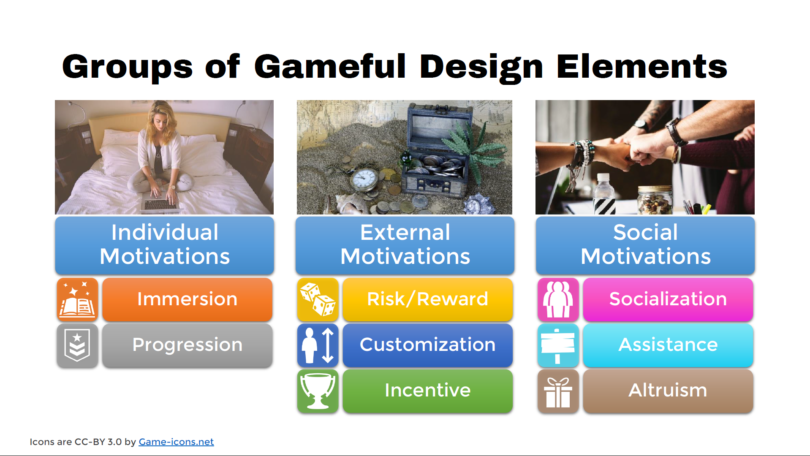Yesterday I published a review of a paper on gamified university-level education. Today, I am going to present some lessons learned from my own experience gamifying a university course. Last Spring I had the opportunity to teach a course on Business Systems Analysis at the University of Waterloo and I took the opportunity to gamify part of the course. Since I was only a sessional instructor for one term, I did not want to change the course structure too much, so I decided to gamify only one part instead of the entire course. I chose to gamify the course assignments. Still, it was a great experience!

When thinking about how to gamify the course’s assignments, I did not want to just mindlessly replace grades with experience points (XP). My main goal was to use gamification to offer students a more natural way of learning the course’s topics. In university courses, assignments are often graded after completed by the students, sometimes with some accompanying feedback to help students understand what they did wrong. However, students are usually not given the chance to try again after learning from their mistakes, and their only chance to prove they have learned their lesson is on the exams. But that is not how learning occurs naturally: it is easier to learn by having a safe opportunity to try several times, learning from the previous mistakes each time. That is how learning naturally occurs in real life, but that is also something that games are very good at. Therefore, that is how I designed the course’s assignments: if a student did not get it right the first time, I would provide some feedback and ask them to try again (correct their answer) and submit it again.
Another design guideline that I set up is that I wanted to give students some freedom to focus on the course topics they were most interested in. Thus, I offered them a variety of different assignments on different topics and gave them the freedom to choose which ones they would like to complete. Assignments covered a variety of topics with a few different formats, such as reading and summarising articles, analysing a problem and suggesting a solution, or drawing diagrams.
I still used XP in the design, as a way of measuring if the students had completed enough assignments. A total of 1,000 XP (or more) would correspond to the maximum grade for the assignments part of the course (10% of the course’s final grade) and any amount less than that would represent a proportional grade. Each assignment was worth 100 to 150 XP (depending on the amount of work required), so each student needed to complete eight assignments on average to achieve the highest grade available. There were a few dozens of different assignments to choose from, so students had a nice degree of freedom to choose.
I also wanted to use an online tool to communicate with the 85 students in the course. After some searching, I decided to use 3D Game Lab by Rezzly, which worked reasonably well for my needs: I could post assignments as quests, review students answers, and either accept them (thus awarding the correspondent amount of XP) or reject them with feedback that allowed them to understand what they needed to improve in their answer before submitting it again. Besides XP, the tool also offered features like levels and badges, so I also used them, but they were not a prominent part of the design. It did not matter what level students were nor which badges they had received in the end, so I do not believe that students paid much attention to them.
Considering how the overall experience occurred, I felt it was positive. Most students completed 1,000 XP or close to it, some even more because they wanted to complete more assignments to receive feedback while studying for the exams. In the evaluations, several students commented the experience points were the best part of the course, praised the feedback they received for completing their assignments, which effectively helped them learn the course content, and some even suggested this model be applied to all courses!
Judging by the positive feedback from students, there are two interesting lessons to be learned (or confirmed) from this experience:
- Gamification can be used to help students learn in a more natural way, by giving them the chance to try several times until they get the quest right and giving them feedback on what they need to improve after each try.
- Gamification can be designed to give students the freedom to pursue the topics they are most interested in, by giving them multiple paths to complete the course requirements.
Nevertheless, I have also observed some aspects that could be improved, so there are also some lessons for future improvement:
- Although there were a few different types of activities, some students still asked for even more variety on types of quests and topics covered.
- Giving students enough feedback to actually improve their answers for each assignment requires more time than usual because the feedback needs to be more detailed than the usual grading feedback. Thus, the instructor needs to allocate enough time.
- Although some students distributed quest completion throughout the course, there was a concentration of quests completed right before the midterm exam and even more right before the final exam, which was also the deadline for completing quests. Thus, the instructor needs to plan their time accordingly or try and encourage a more uniform distribution in quest completion (perhaps establishing intermediate deadlines for completion of different amounts of quests, instead of just a final deadline).
As I said in the beginning, this was an experience with gamiyfing only part of the course; still, it was a great experience and I am sure the lessons learned will be useful for future experiences. I hope they can also be useful to you!




1 Comment